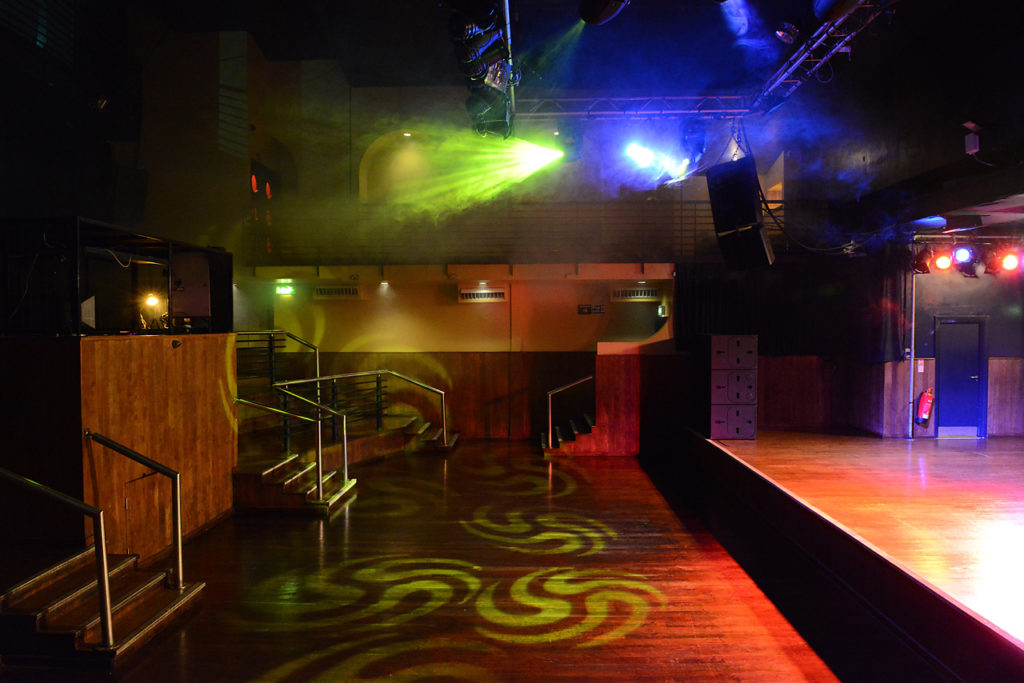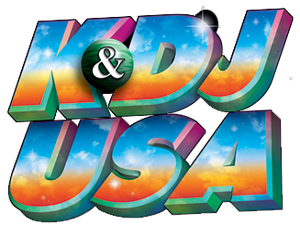Lighting The Club You Work At
by DJ Mike Fright
“A club DJ is a nightclub professional. Just as the chief bartender has special input regarding the club’s liquor order, the club’s DJ should play a major part deciding what lighting and effects to install — and where to install it.”
 A nightclub without a lightshow is not a nightclub; it’s a bar with a sound system. For years now, lights have become a staple even in smaller and rural venues. But, while some club owners still avoid investing in lights and effects, others have wasted money on lights that are dull, unreliable and costly.
A nightclub without a lightshow is not a nightclub; it’s a bar with a sound system. For years now, lights have become a staple even in smaller and rural venues. But, while some club owners still avoid investing in lights and effects, others have wasted money on lights that are dull, unreliable and costly.
If you are a DJ, VJ or KJ working in a nightclub with dusty, outdated lighting that doesn’t suit the club or are stuck in a dark bar that has no effects lighting whatsoever, you owe it to your employer to explain the advantages and the costs of installing an effective lighting system. if you do not understand the cost of lighting and basic lightshow theory, however, a club owner will not give your opinion respectful consideration.
Lighting and lightcraft are generally exciting topics for club patrons as well as for the guys and gals who get paid to play with these expensive toys. Just the thought of a well-equipped light system is enough to get a Pavlovian response from the average disc-dog. But before you get fired up and march into the owner’s office with a handful of color lighting brochures, let me warn you that most club owners see things a little differently than we DJs do.
The typical club owner didn’t open a nightclub because he or she loves music — or lights. They opened the establishment because they want a successful business. Show the typical club owner a lighting brochure, and they will ask about the bottom line. Unless that light machine is capable of spitting out dollars, their gut will tell them to reject any additional costs; after all, the club has plenty of overhead and inventory already.
You must therefore justify any costs with tangible benefits, as well as be ready to answer the owner’s technical questions. Having some familiarity with what lighting can and cannot do will assist you.
Lights can help a club gain a bigger following. A good lightshow is fun to watch and will attract people to the club. For the club owner, that means more customers — and a bigger market share. Why? If two nightclubs are equal in all other respects, the club with the better lightshow will take a little more of the competitor’s business each week.
With a good lighting system, customers stay longer and spend more money. This is measurable income; money that you, the DJ, can use to justify a lighting budget.
For example, if just five customers a week drink just five extra drinks because of lighting, that will gain the club about $1,040 per year of added profit (at $4 per drink). This profit will pay for the cost of a decent lighting system, and the market share gained on the weekends is an additional bonus.
Lightshows help to create ambiance. A good light show can substantially elevate the prestige and status of a club, which can justify higher door/drink prices and attract a more affluent customer base. I can’t help but mention Gables, a club on a lonely country road in West Virginia, an hour and a half drive out of the urban environment of Washington D.C. On Thursdays, Fridays and Saturdays, the parking lot is packed with Virginia, Maryland and D.C. plates, because Gables has found the right mix of upscale trappings, dance music and lighting. Lighting and ambiance are not, however, a substitute for advertising. Lights only affect people after they enter the club. If the club cannot get people in the door, then all the lights and fog machines in the world won’t be of much help. An establishment that wants to substantially improve its customer base and market share must advertise, especially in a competitive nightclub market.
A club DJ is a nightclub professional. Just as the chief bartender has special input regarding the club’s liquor order, the club’s DJ should play a major part deciding what lighting and effects to install — and where to install it. This means that the DJ will have to know what they are talking about and should have some experience working with lighting systems. Think of yourself as not just a DJ, but as a lighting consultant as well. You must have some idea of what can and should be realistically spent on lighting for your particular venue. That means living with the reality of what the club is taking in, as well as realizing that it isn’t always prudent to push for your preferred “dream system.” Sometimes it‘s better to start with something basic and work your way up.
The ideal cost of the lighting is, well, free; meaning that the opportunity cost is equaled or exceeded by the net profit. To figure the cost of lighting, you must realistically estimate the amount of business the lightshow alone will generate. How many more customers and cash flow can you expect as a direct result of your new lightshow? This is a tricky question, and it’s all too easy for eager DJs to inflate the numbers. Try to be as conservative as possible, as this will give you much more credibility in the long run. You want the owner to raise your estimates rather than scoff at your optimism or — in a worst-case scenario — hire another DJ.
After you have estimated the number of potential new customers, you must calculate the added cash flow that will be generated from this influx. To do this, you can add in a door charge for each new customer, and an average bar bill for each customer (depending on the club, a reasonable estimate is $10 to $20 per customer). You may want to add in the additional drinks that will be sold to existing customers. This may seem like sweeping pennies off the floor, but it will help bolster your lighting budget. .
Subtract the price of the lights from the expected profits to determine the actual cost of the lighting. Remember, a club owner wants the lights for free — or less. If you can show the club owner how buying lights will put money in their pocket, they may just review the numbers and then establish a decent lighting budget. However, if the price is too high, the owner will probably pass.
Of course, every DJ wants the most impressive light system money can buy, but your venue may not be able to afford spending more than will be taken in over a single weekend, or in some cases, a weekend night. You may be disappointed that you may not be able to afford the light system of your dreams, but if you convince the owner to spend much more on lights than the business can justify, you may put the club in a tight spot financially. This may not be enough to put your club under, but the owner will take a dim view of any other suggestions you may have.
The DJ who carefully plans the best and most cost-effective lightshow for his or her venue, however, can expect that it’s success will lead to a strong, long and prosperous relationship; and the respect and serious consideration that you will require to implement future ideas and innovations.
